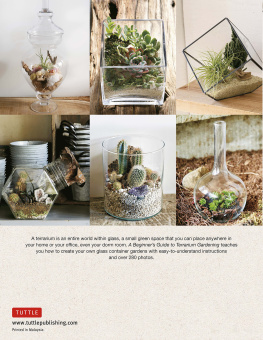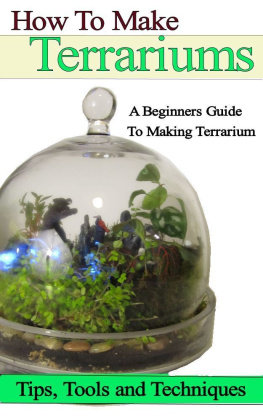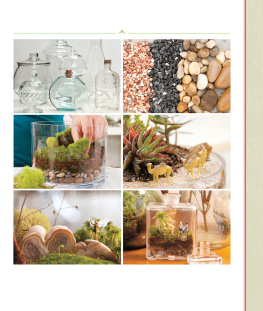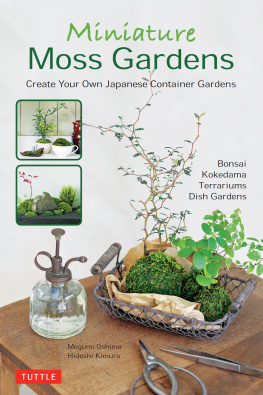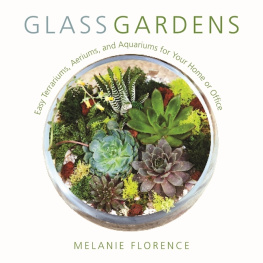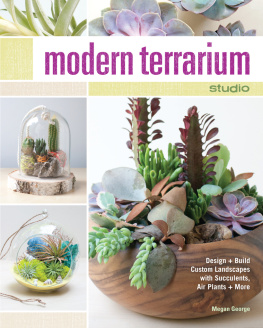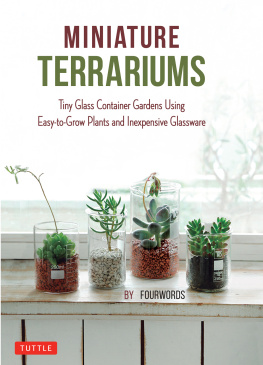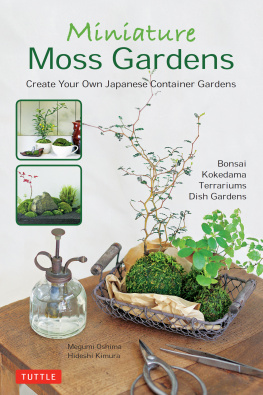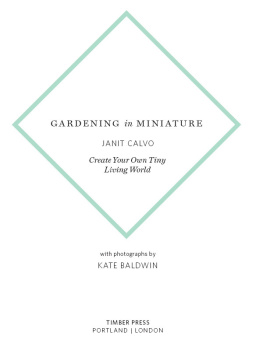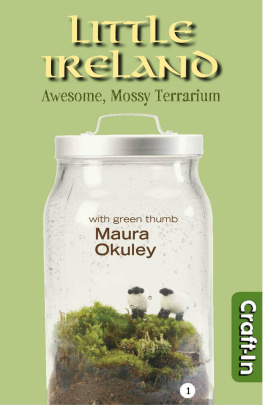TERRARIUM CRAFT

TERRARIUM CRAFT
Create 50 Magical, Miniature Worlds
BY Amy Bryant Aiello & Kate Bryant
PHOTOGRAPHY BY Kate Baldwin

Copyright 2011 by Amy Bryant Aiello & Kate Bryant.
All rights reserved.
Photography by Kate Baldwin.
Published in 2011 by Timber Press, Inc.
The Haseltine Building
133 S.W. Second Avenue, Suite 450
Portland, Oregon 97204-3527
www.timberpress.com
2 The Quadrant
135 Salusbury Road
London NW6 6RJ
www.timberpress.co.uk
Printed in China
Design by Nicki Brandt
Library of Congress Cataloging-in-Publication Data
Bryant Aiello, Amy.
Terrarium craft : create 50 magical, miniature worlds /
Amy Bryant Aiello & Kate Bryant ;
photography by Kate Baldwin. -- 1st ed.
p. cm.
Includes bibliographical references and index.
ISBN 978-1-60469-234-1
1. Terrariums. 2. Glass gardens. I. Bryant, Kate. II. Title.
SB417.B79 2011 635.9'824--dc22
A catalog record for this book is also available from the British Library.
THANKS TO MY HUSBAND, MICHAEL,
for his love and support and my daughter, Chiara Lucia, for just being.
Special thanks to family and friends and to Martha Bergman-Gamblin
and Katie Bailey who have been so helpful.
Amy Bryant Aiello
MY GRATITUDE TO FRIENDS AND FAMILY
who sustained me with beautiful meals, cups of tea, and love.
Kate Bryant

TABLE OF CONTENTS
PREFACE
Making a terrarium involves taking elements of nature and arranging them in a way that is exquisitea collage with nature. Its like capturing the experience of walking in the forest and looking down to see a breathtaking organic arrangement, or spotting an ideal composition in sand, foam, and driftwood on the beach. A terrarium is a snapshot of that perfect array of natural elements, somehow contained yet still wild at the core.
Artemisia, our shop in Portland, Oregon, is a space for me to play, both on a broad scale (the shop is one big, constantly changing installation) and within the confines of the individual terrariums. Plants, shells, stones, crystals, and other natural materials are innately beautifulwe hardly need to do anything to them at alljust spending time in their presence brings out the artist in all of us.
For me, a terrarium is like a secret home inside a home. I often layer materials in the terrariums, showing what is below the surface; like dreams are to our daily lives, something that lives underneath and has a separate reality of its own. Once I begin working on a design, I start to think about making terrariums when I go to sleep and when I wake upI feel the excitement of the muse! I wish that for you as well.
Amy Bryant Aiello


INTRODUCTION
Our natural world is filled with boundless beauty, from the most delicately random arrangements of bark, moss, and lichen on the forest floor to graceful heaps of seaweed, driftwood, and shell tossed up on a beach. In this book, you will learn how to distill the beauty of these natural elements into artful terrariums.
The fifty terrariums shown in these pagesloosely grouped by inspiration into forest, beach, desert, or fantasyincorporate a range of fascinating components, including plants, lichen, moss, crystals, stone, sand, and shells. Every project contains a materials list, as well as detailed instructions for composing and caring for the terrarium (all of which builds on the practical information covered in the first part of the book). And while each of the compositions is beautiful enough to be worth recreating, they were really designed to inspireto serve as catalysts to ignite your own creativity and personal vision. Far from being meticulously planned, they were made with what artist Amy Bryant Aiello had available at her shop at the time the book was created. Even the process of making them was intuitive, if not somewhat spontaneouspieces were added, swapped out, and gently prodded until they looked right, even during the photo shoot. The idea is to play with the materials and enjoy the process itself, while accepting the delicious imperfection of it.
A walk in the woods, along a beach, or through a dry canyon would be ideal for getting in an experimental frame of mind. Natural scenerywind-tossed sand, tawny beach grass, or mossy rocksis the best inspiration for creating these terrarium collages. In essence, making a terrarium really begins with your own relationship with nature. As you gather your materials, let them guide your creative process. Start with materials you love, keep an open mind, and allow them to take you somewhere unexpected. The beauty already existsyou are the curator, selecting which pieces will be included and assembling them in a way that delights you.
Once made, set your terrarium where you can enjoy and observe it. If you arent a gardener or even if you think of yourself as a brown thumb, you can find living plants that are easy to care foror captivating dried mosses and lichens that require no attention at all, save for admiration. Add a significant personal memento and a terrarium can even be a kind of altar, encapsulating dreams, passions, and memories. Simple to care for yet highly expressive, such terrarium designs bring the natural world closer to homeand us closer to nature.

PRACTICAL MATTERS

CLOCKWISE FROM BACK LEFT: tall, skinny vase, large bubble bowl, stemmed votive glass (inside bubble bowl), large teardrop (hanging in backdrop), French canning jar, lidded apothecary jar, small teardrop, large and small pyramid vases, small bud vase, cloche on tray, science jar.
A helpful primer on all things terrarium, this comprehensive section covers material choices, plant care information, and general terrarium-making techniques and tips. Before you embark on a terrarium project, take some time to read about the many types of glass containers, the various substrates, and the complementary materials including stones, shells, crystals, moss, lichen, architectural plants, and miscellaneous embellishments. Besides your own patch of nature and local shops, the resource section (page 188) contains a list of places to purchase materials. Always check local, state, and federal regulations before collecting any natural materialsand take only what you need.
CONTAINERS
It all begins with the container. A terrarium needs to be clear glass, not only so you can admire the contents but also so any plants inside can absorb needed light. Aside from these obvious practicalities, the glistening and reflective qualities of the glass itself are an essential part of the beauty of the modern terrarium.
Next page

